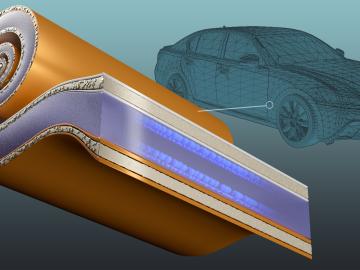
Filter News
Area of Research
- Advanced Manufacturing (4)
- Biological Systems (1)
- Biology and Environment (34)
- Computational Biology (1)
- Computational Engineering (1)
- Computer Science (2)
- Electricity and Smart Grid (2)
- Energy Frontier Research Centers (1)
- Energy Science (99)
- Functional Materials for Energy (1)
- Fusion and Fission (2)
- Isotopes (2)
- Materials (54)
- Materials for Computing (10)
- National Security (8)
- Neutron Science (21)
- Nuclear Science and Technology (3)
- Quantum information Science (1)
- Sensors and Controls (1)
- Supercomputing (29)
- Transportation Systems (2)
News Type
News Topics
- (-) Bioenergy (46)
- (-) Biomedical (32)
- (-) Composites (25)
- (-) Coronavirus (28)
- (-) Grid (43)
- (-) Nanotechnology (44)
- (-) Transportation (73)
- 3-D Printing/Advanced Manufacturing (93)
- Advanced Reactors (27)
- Artificial Intelligence (62)
- Big Data (34)
- Biology (51)
- Biotechnology (16)
- Buildings (43)
- Chemical Sciences (57)
- Clean Water (16)
- Computer Science (121)
- Critical Materials (23)
- Cybersecurity (21)
- Education (3)
- Element Discovery (1)
- Emergency (2)
- Energy Storage (80)
- Environment (99)
- Exascale Computing (24)
- Fossil Energy (2)
- Frontier (25)
- Fusion (28)
- High-Performance Computing (58)
- Hydropower (6)
- Irradiation (3)
- Isotopes (29)
- ITER (6)
- Machine Learning (31)
- Materials (107)
- Materials Science (94)
- Mathematics (3)
- Mercury (5)
- Microelectronics (1)
- Microscopy (31)
- Molten Salt (8)
- National Security (26)
- Neutron Science (88)
- Nuclear Energy (55)
- Partnerships (36)
- Physics (31)
- Polymers (24)
- Quantum Computing (21)
- Quantum Science (46)
- Security (13)
- Simulation (24)
- Software (1)
- Space Exploration (13)
- Statistics (2)
- Summit (32)
Media Contacts

Strengthening the competitiveness of the U.S. transportation industry depends on developing domestic EV batteries that combine rapid charging with long-range performance — two goals that often conflict. Researchers at ORNL have addressed this challenge by redesigning a key battery component, enabling fast, 10-minute charging while improving energy density and reducing reliance on copper.

Researchers at ORNL have developed an innovative new technique using carbon nanofibers to enhance binding in carbon fiber and other fiber-reinforced polymer composites – an advance likely to improve structural materials for automobiles, airplanes and other applications that require lightweight and strong materials.

As demand for energy-intensive computing grows, researchers at ORNL have developed a new technique that lets scientists see how interfaces move in promising materials for computing and other applications. The method, now available to users at the Center for Nanophase Materials Sciences at ORNL, could help design dramatically more energy-efficient technologies.

Scientists at ORNL have developed a vacuum-assisted extrusion method that reduces internal porosity by up to 75% in large-scale 3D-printed polymer parts. This new technique addresses the critical issue of porosity in large-scale prints but also paves the way for stronger composites.

Scientists at Oak Ridge National Laboratory and the University of Colorado Boulder used a gene-silencing tool and a large library of molecular guides to understand how photosynthetic bacteria adapt to light and temperature changes. They found that even partial suppression of certain genes yielded big benefits in modifying the stress response of wild microbes.
Vilmos Kertesz, senior staff in the Biosciences Division at ORNL, has received a 2025 Al Yergey Mass Spectrometry Scientist Award from the American Society for Mass Spectrometry. The award recognizes his contributions to the fields of analytical chemistry and mass spectrometry.

Gerald Tuskan, director of the Center for Bioenergy Innovation and a Corporate Fellow at ORNL, has been awarded the Marcus Wallenberg Prize, the world’s highest honor in the field of forestry, for his pioneering work in sequencing and analyzing the first tree genome.
Daniel Jacobson, distinguished research scientist in the Biosciences Division at ORNL, has been elected a Fellow of the American Institute for Medical and Biological Engineering, or AIMBE, for his achievements in computational biology.

Working at nanoscale dimensions, billionths of a meter in size, a team of scientists led by ORNL revealed a new way to measure high-speed fluctuations in magnetic materials. Knowledge obtained by these new measurements could be used to advance technologies ranging from traditional computing to the emerging field of quantum computing.

Neus Domingo Marimon, leader of the Functional Atomic Force Microscopy group at the Center for Nanophase Materials Sciences of ORNL, has been elevated to senior member of the Institute of Electrical and Electronics Engineers.


